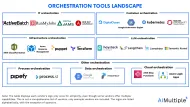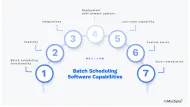Automic Automation in 2024: Analysis based on 110+ Reviews
Automic Automation, as a part of Broadcom’s workload automation tools, enables its users to automate complex IT processes under one platform, thus minimizing the need for alternative solutions for different business operations.1
Despite its automation capabilities, it also has below average user satisfaction performance as indicated by a B2B review platform.2One of the possible causes for such performance can be lower user ratings compared to other automation platforms (See Table 1) and user reviews highlighting shortcomings in file transfer capabilities, dashboard building features and customer services (See Automic Automation shortcomings).
We will provide a review based evaluation of Automic Automation, along with its key features, capabilities and alternatives to give a comprehensive outlook on the solution.
Review based evaluation of Automic Automation
We included user reviews from B2B review platforms G2, PeerSpot, and Trustradius to provide insights on Automic Automation’s capabilities.
| Platform | User rating | Number of reviews |
|---|---|---|
| PeerSpot | 4.1/5 | 85 |
| G2 | 4.2/5 | 15 |
| Trustradius | 7.9/10 | 14 |
Table 1: Automic Automation user reviews
Automic Automation Advantages
Ease of use and scalability: Users report that Automic Automation platform has a simple interface with high stability and scalability. See Figure 1.

SAP automation: Automic Automation’s SAP automation feature is considered to be highly valuable. See Figure 2.

Automation capacities: The solution allows business process automation, workload automation, service orchestration, and PR automation under one platform enabling users to manage automation processes without the need of an extra automation tool. See Figure 3.

Template features: Users find Automic Automation’s predefined templates that are used for application-specific jobs beneficial. See Figure 4.

Automic Automation Shortcomings
Flexibility options: Users suggest more flexible options for dashboard building features.7
Customer support services: Users reported that the solution’s customer services are not efficient enough to resolve issues on time. See Figure 5.

File transfer feature: Users find the solution’s file transfer feature not as efficient as other automation platforms and suggest improvements for its file transfer capabilities. See Figure 6.

Key features and capabilities of Automic Automation
Automic Automation is an enterprise job scheduling and IT automation solution focused on streamlining complex workflows, orchestration of business services, support SRE teams to minimize mean time to resolution (MTTR) and increase effectiveness of digital business automation.
Automic Automation’s key features include:
Multi-tenancy
As a part of Automic Automation’s multi-client concept, plug-in and ready-made workflow options are offered to support multi-tenant processes.
Automation engine scripting
The solution’s automation scripting feature allows organizations to code workload processes with its scripting language.
Native Kubernetes deployment
Automic Automation’s native Kubernetes deployment option allows for minimizing operational complexity related with deploying, updating, and scaling Automic Automation instances, also helping to optimize cloud investments.
AIOps intelligent remediation
Automic Automation v21 introduces AIOps monitoring with pre-built intelligent recommendations and automated remediation capabilities.
This feature is designed to minimize MTTR by automated diagnostics and remediation, while supporting the creation of more resilient production environments.
Web interface features
Automic Automation allows for a variety of web interface features such as copying, pasting, and exporting variable objects, interactive traffic lights in process monitoring, drag-and-drop support for scheduling, tooltips, and more bulk operations to optimize and automate business processes.
Integration
Automic Automation platform enables integrations with Apache, Tomcat, Remedy, VMWare, MySql, Jenkins, Office365, NetScaler, Siebel, SSH, and SAP.
Automic Automation for Oracle E-Business Suite
With the aim to optimize Oracle E-Business Suite investment and enable integration with other business apps, the solution provides:
- a central point of control for manual process automation,
- coordination of file transfers between remote, external and internal systems,
- error detection by scanning data files and system logs.
Workload automation for Informatica
The integration with Informatica enables users to schedule, control and monitor workflows, tasks, and sessions; job definition creation based on Informatica parameters; dependencies management including file transfers and system tasks operations; and automated notifications for failures and recoveries.
Automation analytics and intelligence
Broadcom’s Automation Analytics & Intelligence integrates with Automic Automation with the aim of improving change control by stimulating possible changes prior to production to optimize batch processing and predicting SLA outcomes and manage proactive alerts to minimize failures of IT business processes.
Monitoring and auditing
The solution’s automation engine includes reporting and auditing features and supports output files and reports generation through object execution processes.
Automic Automation alternatives
Workload automation platforms including Tidal Workload Automation (TWA), Stonebranch, ActiveBatch, and Redwood RunMyJobs are alternatives to Automatic Automation. Check out our detailed list on Automic Automation alternatives.
Transparency statement
AIMultiple collaborates with multiple workload automation vendors including Redwood RunMyJobs, ActiveBatch and Stonebranch.
External resources
- 1. “Automic Workload Automation Reviews and Pricing“. PeerSpot. Retrieved 27 February, 2024.
- 2. “Best Workload Automation Software in 2024: Compare Reviews on 80+ Products“. G2. Retrieved February 27, 2024.
- 3. “Automic Workload Automation Reviews and Pricing“. PeerSpot. Retrieved 27 February, 2024.
- 4. “Automic – IT Process Automation“. TrustRadius. Retrieved 27 February, 2024.
- 5. “Automic Workload Automation Reviews and Pricing“. PeerSpot. Retrieved 27 February, 2024.
- 6. “Automic Workload Automation Reviews and Pricing“. PeerSpot. Retrieved 27 February, 2024.
- 7. “Automic Automation Reviews 2024: Details, Pricing, & Features“. G2. Retrieved 27 February, 2024.
- 8. “Automic Workload Automation Reviews and Pricing“. PeerSpot. Retrieved 27 February, 2024.
- 9. “Automic Workload Automation Reviews and Pricing“. PeerSpot. Retrieved 27 February, 2024.

Cem is the principal analyst at AIMultiple since 2017. AIMultiple informs hundreds of thousands of businesses (as per Similarweb) including 60% of Fortune 500 every month.
Cem's work has been cited by leading global publications including Business Insider, Forbes, Washington Post, global firms like Deloitte, HPE, NGOs like World Economic Forum and supranational organizations like European Commission. You can see more reputable companies and media that referenced AIMultiple.
Throughout his career, Cem served as a tech consultant, tech buyer and tech entrepreneur. He advised enterprises on their technology decisions at McKinsey & Company and Altman Solon for more than a decade. He also published a McKinsey report on digitalization.
He led technology strategy and procurement of a telco while reporting to the CEO. He has also led commercial growth of deep tech company Hypatos that reached a 7 digit annual recurring revenue and a 9 digit valuation from 0 within 2 years. Cem's work in Hypatos was covered by leading technology publications like TechCrunch and Business Insider.
Cem regularly speaks at international technology conferences. He graduated from Bogazici University as a computer engineer and holds an MBA from Columbia Business School.
Sources:
AIMultiple.com Traffic Analytics, Ranking & Audience, Similarweb.
Why Microsoft, IBM, and Google Are Ramping up Efforts on AI Ethics, Business Insider.
Microsoft invests $1 billion in OpenAI to pursue artificial intelligence that’s smarter than we are, Washington Post.
Data management barriers to AI success, Deloitte.
Empowering AI Leadership: AI C-Suite Toolkit, World Economic Forum.
Science, Research and Innovation Performance of the EU, European Commission.
Public-sector digitization: The trillion-dollar challenge, McKinsey & Company.
Hypatos gets $11.8M for a deep learning approach to document processing, TechCrunch.
We got an exclusive look at the pitch deck AI startup Hypatos used to raise $11 million, Business Insider.
To stay up-to-date on B2B tech & accelerate your enterprise:
Follow on


Comments
Your email address will not be published. All fields are required.